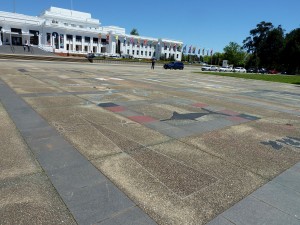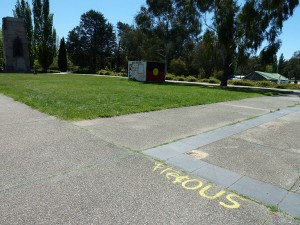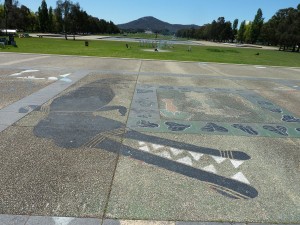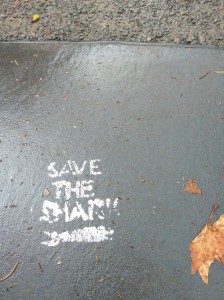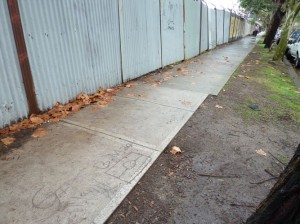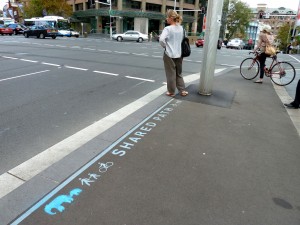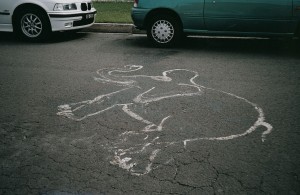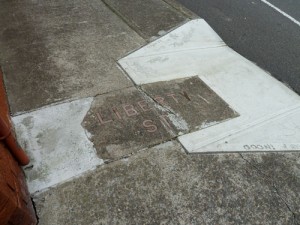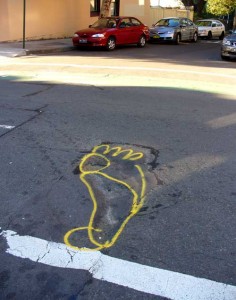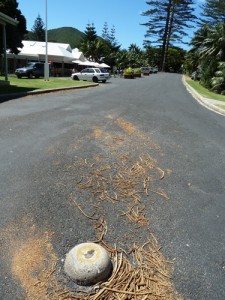All around the world the pavement has a symbolic role as well as a functional one so that, for example, during natural disasters or mass acts of civil disobedience broken asphalt is often invoked in words or pictures to depict the havoc created. Similarly, news services and bloggers publish images of pavement stains to represent the unpublishable and they scan pavement graffiti to capture the feelings of ‘the person in the street’.
Here, then, is a chronological catalogue of major news events of 2011 as told via the medium of the pavement. None of the images in this blog post is mine. I wasn’t there; I was too busy hunched over in my computer corner getting on with the Pavement Graffiti project.
 Queensland floods
“One of the few silver linings to the devastating Queensland floods could be an eventual stimulus to the economy as major repair work begins … It is still a matter of some conjecture as to which individual companies might profit. One likely candidate is Boral, which has market-leading positions in asphalt and other material for road.†(The Age, Melbourne)
 Cyclone Yasi in Queensland
 “That stretch of asphalt you see there, buried under the remains of the beach? That’s the Bruce Highway, the main (and virtually only) road to communities up the coast, and the main tourist town of Cairns. It will be a long time before Queensland has recovered from this.†(Must Use Bigger Elephants blog; ABC News, Australia)
“That stretch of asphalt you see there, buried under the remains of the beach? That’s the Bruce Highway, the main (and virtually only) road to communities up the coast, and the main tourist town of Cairns. It will be a long time before Queensland has recovered from this.†(Must Use Bigger Elephants blog; ABC News, Australia)
 Earthquake, tsunami and nuclear meltdown in Japan
“Workers told how the earthquake ripped through the plant, immediately knocking out the main power. A ghastly boom was heard in the suppression chamber of reactor 4, said Kenji Tada, who was there at the time. Cracks started ripping in the asphalt and the sides of the building. They fled before the tsunami arrived and did its worst.†(The Telegraph, UK)
 Christchurch earthquake
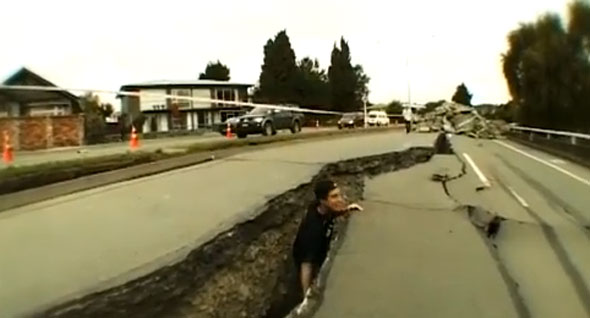 “This is the closest I have seen to skating in post-apocalyptic world, which is my fantasy.â€Â (Skateboarding magazine.com)
“This is the closest I have seen to skating in post-apocalyptic world, which is my fantasy.â€Â (Skateboarding magazine.com)
 Osama bin Laden killed
“Days after Osama bin Laden’s demise, America’s burning concern—the most urgent outstanding question, at least according to Google search trends—had nothing to do with al Qaeda, terrorism, or torture. No, the death of the world’s most-wanted man has the country thinking about something else entirely: how to get buff. ‘Navy SEAL training’ followed closely by ‘Navy SEAL workout’ were the only bin Laden-related search terms in the Top 10 … SEAL training is the most ferocious workout in the free world … The best are eventually tapped for the elite Seal Team Six—the squad that got bin Laden … On the ‘grinder’, a black asphalt courtyard, would-be SEALs spend hours doing mass calisthenics. In the pool, they are ‘drown-proofed’ by swimming with bound arms and legs. On the shore, they experience ‘surf torture’ …†(The Daily Beast, USA)
 Cadel Evans wins the Tour de France
 “ ‘Relief, for sure,’ says Cadel Evans’s mum, describing what is was like to watch her son on TV during the early hours of Sunday finally set himself up to become the first Australian to win cycling’s Tour de France.†(The Australian; Herald Sun)
“ ‘Relief, for sure,’ says Cadel Evans’s mum, describing what is was like to watch her son on TV during the early hours of Sunday finally set himself up to become the first Australian to win cycling’s Tour de France.†(The Australian; Herald Sun)
 Explosion and massacre in Norway
 “Blood smears the pavement, as a victim is treated outside government buildings in the centre of Oslo, Friday July 22, 2010, following an explosion that tore open several buildings including the prime minister’s office, shattering windows and covering the street with documents.†(WHAS11.com; AP photo)
“Blood smears the pavement, as a victim is treated outside government buildings in the centre of Oslo, Friday July 22, 2010, following an explosion that tore open several buildings including the prime minister’s office, shattering windows and covering the street with documents.†(WHAS11.com; AP photo)
 Riots in England
“After the rioting every night this week, the news headlines told a bleak story of communities under attack. But hours later locals wearing wellies and washing up gloves were reclaiming the streets with brooms, bin bags and dustpans … The main problem was broken glass from shopfronts … The hardest thing was cleaning up the remains of burnt-out cars … A community is forged on shared values. So, it’s understandable that local residents are keen to mobilise for a clean up, says Tony Cassidy, a psychologist at the University of Ulster … the immediate urge is to remove the damage that resembles an ‘ugly stain’ on their neighbourhood.†(BBC News Magazine)
Royal wedding
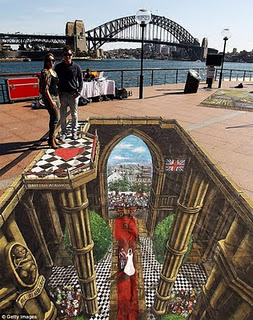 “To encourage more Australians to visit the UK British street artist Joe Hill has created dazzling 3D image showing the iconic Royal Wedding of Princess Catherine and Prince William. The bird’s eye view of Prince William and Princess Catherine’s nuptials can actually be seen on a Sydney pavement.†(Prince William Wedding News blog)
“To encourage more Australians to visit the UK British street artist Joe Hill has created dazzling 3D image showing the iconic Royal Wedding of Princess Catherine and Prince William. The bird’s eye view of Prince William and Princess Catherine’s nuptials can actually be seen on a Sydney pavement.†(Prince William Wedding News blog)
 Steve Jobs dies
 “Ahmed Shafai, of Palo Alto, writes ‘Steve, you made our lives easier’ on the pavement outside the Jobs home in Palo Alto, California†(BBC News World)
“Ahmed Shafai, of Palo Alto, writes ‘Steve, you made our lives easier’ on the pavement outside the Jobs home in Palo Alto, California†(BBC News World)
 Occupy Wall Street
“In a tense showdown above the East River, the police arrested more than 700 demonstrators from the Occupy Wall Street protests who took to the roadway as they tried to cross the Brooklyn Bridge on Saturday afternoon. The police said it was the marchers’ choice that led to the enforcement action. ‘Protesters who used the Brooklyn Bridge walkway were not arrested,’ Paul J. Browne, the chief spokesman for the New York Police Department, said. ‘Those who took over the Brooklyn-bound roadway, and impeded vehicle traffic, were arrested’. But many protesters said they believed the police had tricked them …†(New York Times)
 Muamar Gaddafi is overthrown and killed
“In Benghazi, on the main square where it all started, they were slaughtering camels in celebration … And in the cafes, people were watching TV pictures – more graphic than any shown in Britain – of a bloodied Gaddafi dragged along and beaten, feebly protesting, before a gun was put to his head. The picture then cut to the dead ex-leader being rolled onto the pavement, blood pooling from the back of his skull.†(The Telegraph, UK)
 Protests in Egypt continue
“Fresh clashes erupted in Cairo between police and protesters demanding the end of military rule … A pitched battle between hardcore protesters and armed riot police has been going for five days straight. The fight turned a few-block radius of downtown Cairo into a virtual war zone. Police and protesters formed ever-shifting battle lines delineated by torched-out car skeletons and blackened sheets of corrugated metal, along a street littered with broken bottles and chunks of asphalt.†(Global Post)
 Leveson Inquiry into the phone-hacking scandal
“Sheryl Gascoigne, the ex-wife of former England footballer Paul Gascoigne, is now giving evidence to the inquiry … Gascoigne says journalists who followed her ‘hoped I would give birth on the pavement’ … She is speaking about the effect of the media pursuit had on her family. She says it was especially tough on her children, who often could not go out and play.†(The Huffington Post, UK)
 Conference on Global Warming, Durban
As the year neared its close this conference gave commentators the opportunity to trot out a collection of familiar pavement metaphors.
 “Perhaps it was Yogi Berra, the great baseball player, who best summed up the results of the latest fraught round of climate talks … ‘When you come to a fork in the road,’ he said, ‘take it.’ For the past two years, ever since the disappointing Copenhagen climate summit, the 194 negotiating nations have stood indecisively at just such a junction. In one direction leads a steep and rugged pathway to a global agreement – legally binding on developed and developing countries alike – to cut emissions of the greenhouse gases that cause global warming. In the other lies a gentler and more beguiling roadway, paved with voluntary measures and good intentions, which looks like leading to an ultimately hellish climate.†(The Telegraph, UK)
“Durban Platform Paves Way for Global Climate Treaty by 2015 … By the end of the meeting, the Durban Platform for Enhanced Action was agreed to by 190 nations …  In addition to a roadmap for a more comprehensive climate treaty, the EU and nine other nations also pledged to take new emission reduction targets under the Kyoto Protocol …†(Carbon Capitalist)
 Occupy Wall Street movement continues
![occupy-pavement[1]](http://www.meganix.net/pavement/wp-content/uploads/2011/12/occupy-pavement1.jpg) “Yep… Occupy pavement… Works for me… What a lost cause… I have news for these idiots: Wall Street never missed a step. And they were up there in their glass towers looking down and laughing. Absolutely wasted effort on the part of these street people…†(Burton Blog)
“Yep… Occupy pavement… Works for me… What a lost cause… I have news for these idiots: Wall Street never missed a step. And they were up there in their glass towers looking down and laughing. Absolutely wasted effort on the part of these street people…†(Burton Blog)
Not a good note to end on, I’m sorry. But to all my readers, thank you for your support and encouragement. I hope the coming year is a fulfilling one for you.
Megan
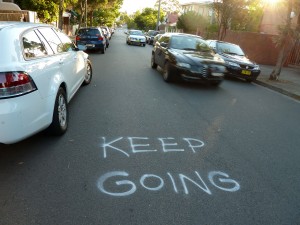








![occupy-pavement[1]](http://www.meganix.net/pavement/wp-content/uploads/2011/12/occupy-pavement1.jpg)
